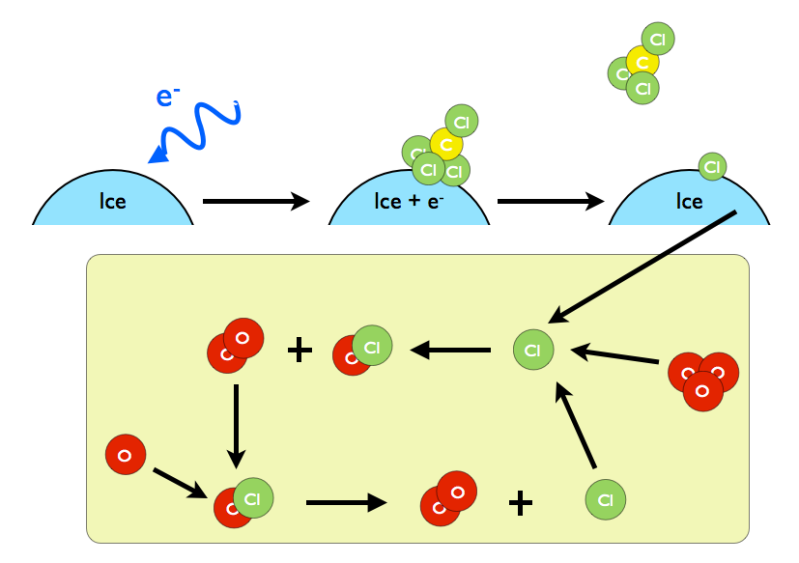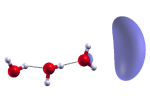 Research
Research
My current area of research is in the application of Quantum Mechanics to model atmospheric systems, namely looking at the interface between multiple water molecules $latex (H_2O)_n&s=-2$ forming nano clusters and the attachment of an excess electron forming an anionic species $latex (H_2O)^{-}_n&s=-2$. These models are important in multiple disciplines, as in biology anionic water clusters could be responsible for radiation damage, pollutants modelled in anionic water clusters are important for atmospheric science as the additional charge could potentially act as a catalyst in the atomic dissociation of the Halides in the pollutants forming free radicals.

The CR reaction pathway for the Molina Cycle
I am studying different sized water cluster models and how accurate they are as an approximation for atmospheric sciences, initialing looking at the sizes required to bind an excess electron to the geometry, defined as a negative Vertical Detachment Energy (VDE), the energy gained from the addition of an extra electron into the anionic geometrical structure, denoted by the index '1'.
$latex E_{VDE} = E^{*}_{1} - E_1$
Particular attention has been taken to the dimer $latex (H_2O)_2&s=-2$ in both the neutral and anionic forms, and the water trimer $latex (H_2O)_3&s=-2$, where quantum dynamics have been performed on the trimer using the Car-Parrinello Molecular Dynamics to allow the system to evolve in time, where the electronic wave-functions effectively follow the ionic movements and stay close to the Born-Oppenheimer surface. We have seen that in the anionic water trimer the favoured geometrical structure is a linear shape, with the loss of a hydrogen bond, which has lead to the discussion that the geometry is defined through the maximisation of the dipole moment of the structure, allowing the electron to become dipole bound.

Linear water trimer, with the contour showing 90% of the excess electron density.
Further work has been undertaken into the water dimer, looking at the system using time-dependent Density Functional Theory (TD-DFT) allowing us to observe the evolution of the electronic wave-functions in time, and study the response function in a linear regime. Through this the far infra-red (FIR) spectra of the system can be constructed and observed. As a significant aside to this TD-DFT project a biologically important molecule $latex H_2O-NO&s=-2$ is being studied, NO is well known as a neuro-receptor, and plays important roles in the body.
Continual increase in the number of water molecules studied has led to the creation of deformed ice surfaces which allow the spatial localisation of an excess electron. This has been considered a good candidate model for Cosmic Ray induced dissociation of CFC's which is a different reaction pathway for the Molina cycle. Excess electron induced catalysis has been seen to occur on the simplest CFC ($latex CCl_4&s=-2$) in an almost instantaneous time frame (sub pico-seconds), where the formation of the Cl free radical is more energetically stable than the whole CFC on the surface. It was observed that the radical is triply hydrogen bonded to the surface, with the additional electron spatially localised on the halogen.

Dissociated CFC with halogen free radical bound through hydrogen bonds to the ice surface.
Further research will be completed into the modelling of pollutants with larger water clusters, using the long range Coulomb Screen implemented into the Plane Waves Density Functional Theory (DFT) code Quantum ESPRESSO. Where of particular importance will be the observation of the dynamical behaviour of the structures at finite temperatures using the CPMD engine.
 Research
Research

